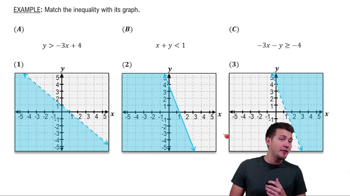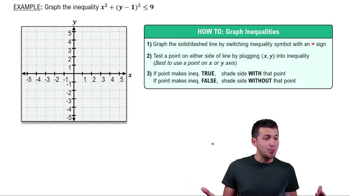Table of contents
- 0. Review of Algebra4h 16m
- 1. Equations & Inequalities3h 18m
- 2. Graphs of Equations43m
- 3. Functions2h 17m
- 4. Polynomial Functions1h 44m
- 5. Rational Functions1h 23m
- 6. Exponential & Logarithmic Functions2h 28m
- 7. Systems of Equations & Matrices4h 6m
- 8. Conic Sections2h 23m
- 9. Sequences, Series, & Induction1h 19m
- 10. Combinatorics & Probability1h 45m
7. Systems of Equations & Matrices
Graphing Systems of Inequalities
Problem 18
Textbook Question
Graph each inequality. 2x > 3 - 4y
 Verified step by step guidance
Verified step by step guidance1
Rewrite the inequality in slope-intercept form (y = mx + b). Start by isolating the y-term: 2x > 3 - 4y becomes 4y > 3 - 2x.
Divide each term by 4 to solve for y: y > (3/4) - (1/2)x.
Identify the slope and y-intercept from the inequality y > (3/4) - (1/2)x. The slope (m) is -1/2 and the y-intercept (b) is 3/4.
Graph the line y = (3/4) - (1/2)x using the slope and y-intercept. Since the inequality is 'greater than' (y >), use a dashed line to indicate that points on the line are not included in the solution.
Shade the region above the line to represent the solution to the inequality y > (3/4) - (1/2)x, as this is where y-values are greater than the line.
Recommended similar problem, with video answer:
 Verified Solution
Verified SolutionThis video solution was recommended by our tutors as helpful for the problem above
Video duration:
5mPlay a video:
Was this helpful?
Key Concepts
Here are the essential concepts you must grasp in order to answer the question correctly.
Inequalities
Inequalities are mathematical expressions that show the relationship between two values when they are not equal. They use symbols such as '>', '<', '≥', and '≤' to indicate whether one side is greater than, less than, or equal to the other. Understanding how to manipulate and graph inequalities is essential for visualizing solutions in a coordinate system.
Recommended video:

Linear Inequalities
Graphing Linear Inequalities
Graphing linear inequalities involves representing the solutions of an inequality on a coordinate plane. This typically requires first converting the inequality into an equation to find the boundary line, which is then graphed. The area that satisfies the inequality is shaded, indicating all possible solutions, while the line itself is dashed for '>' or '<' and solid for '≥' or '≤'.
Recommended video:

Linear Inequalities
Slope-Intercept Form
The slope-intercept form of a linear equation is expressed as y = mx + b, where m represents the slope and b represents the y-intercept. This form is particularly useful for graphing linear inequalities, as it allows for easy identification of the line's slope and where it crosses the y-axis. Converting the given inequality into this form can simplify the graphing process.
Recommended video:
Guided course

Slope-Intercept Form

 7:2m
7:2mWatch next
Master Linear Inequalities with a bite sized video explanation from Patrick Ford
Start learning





